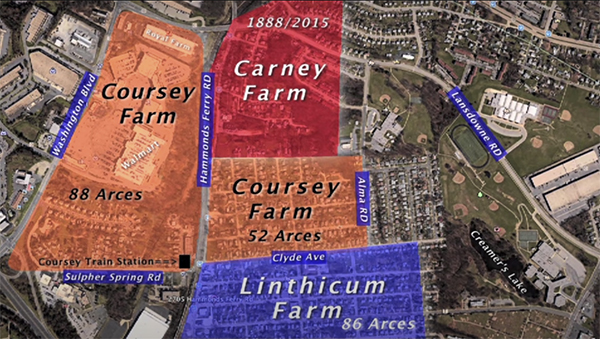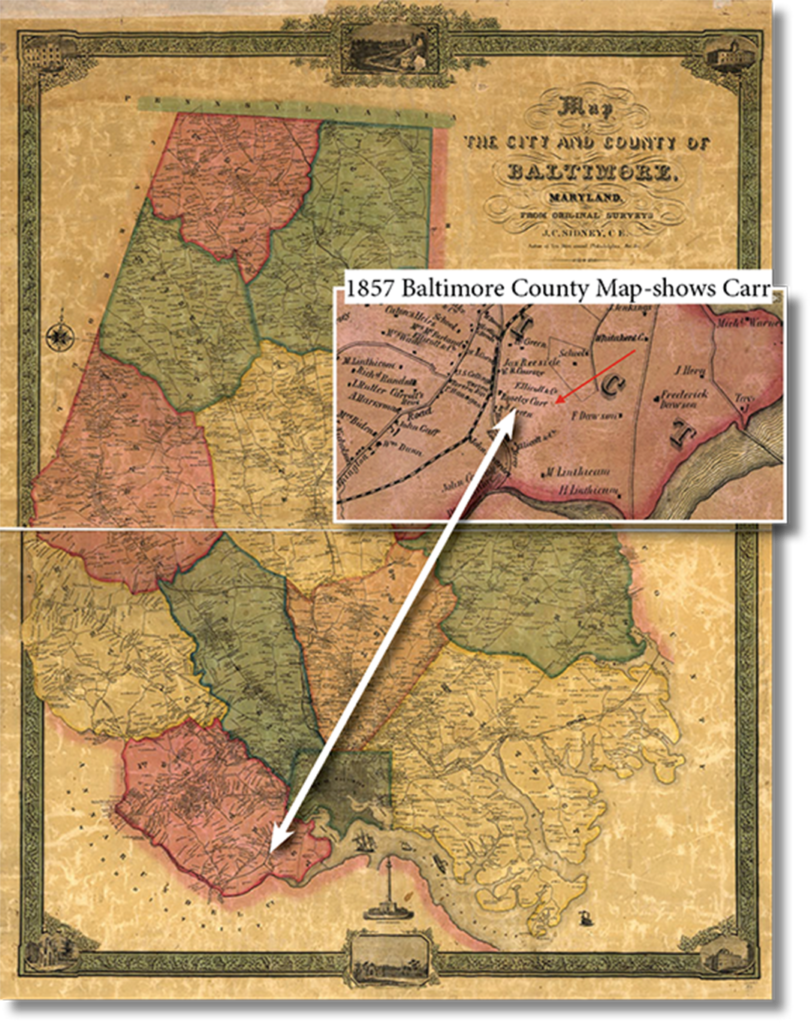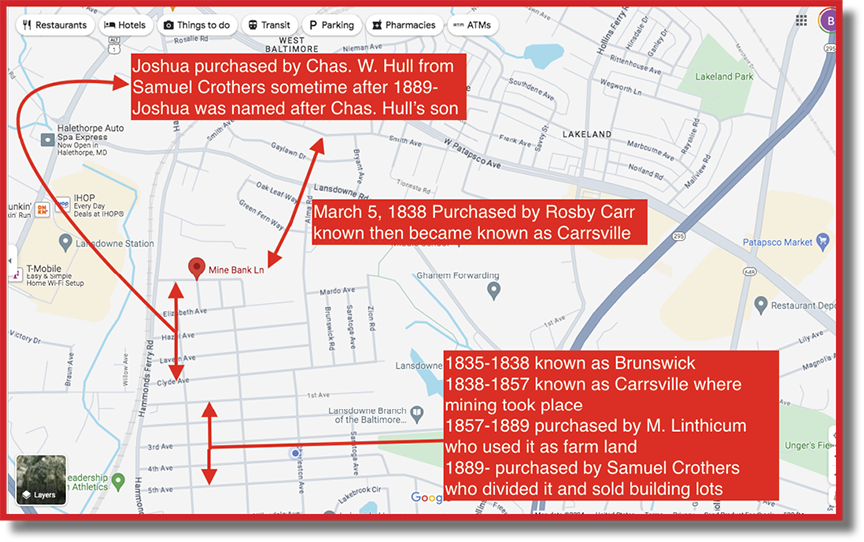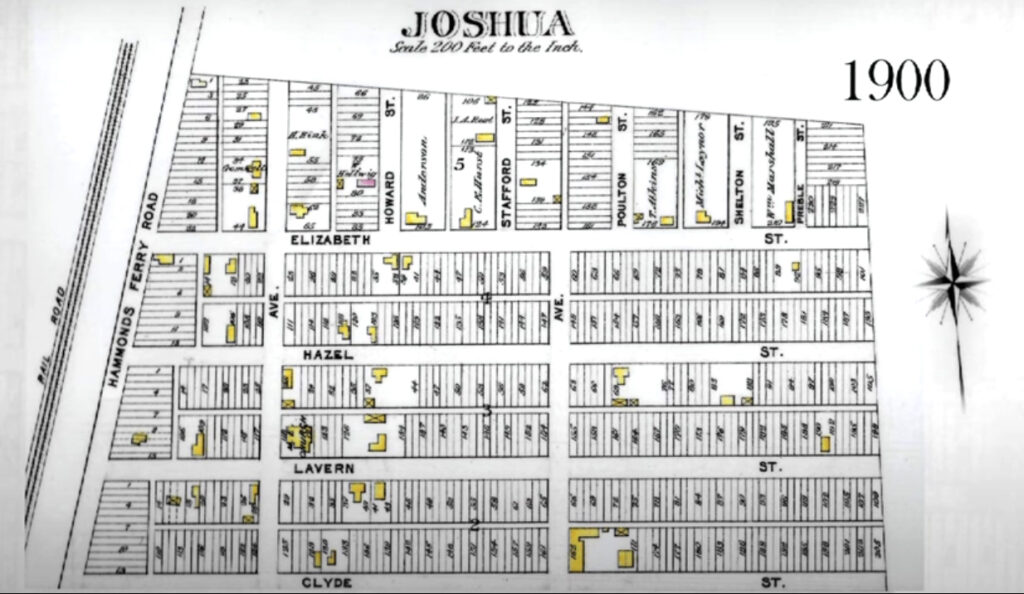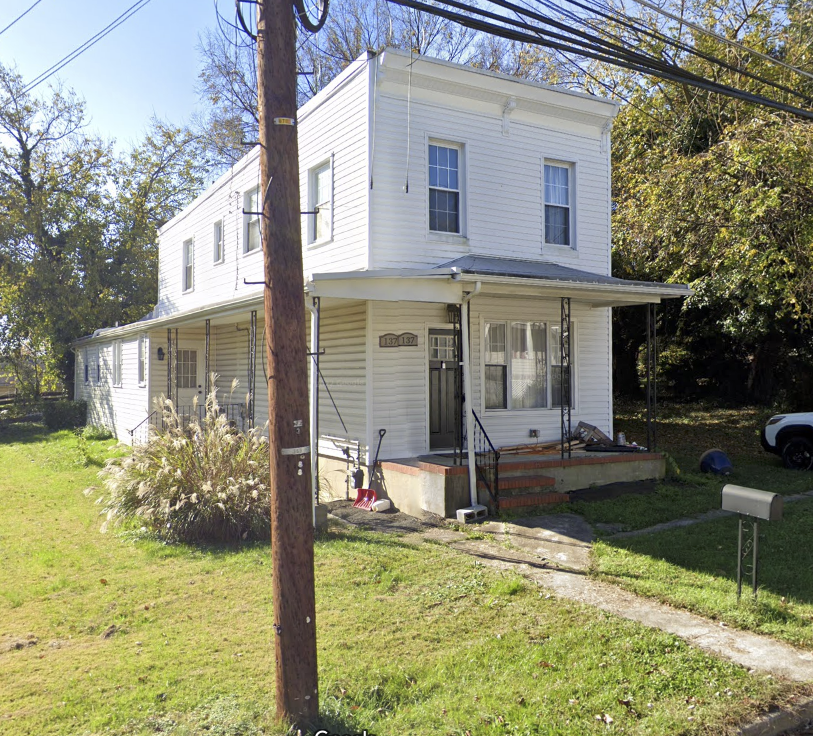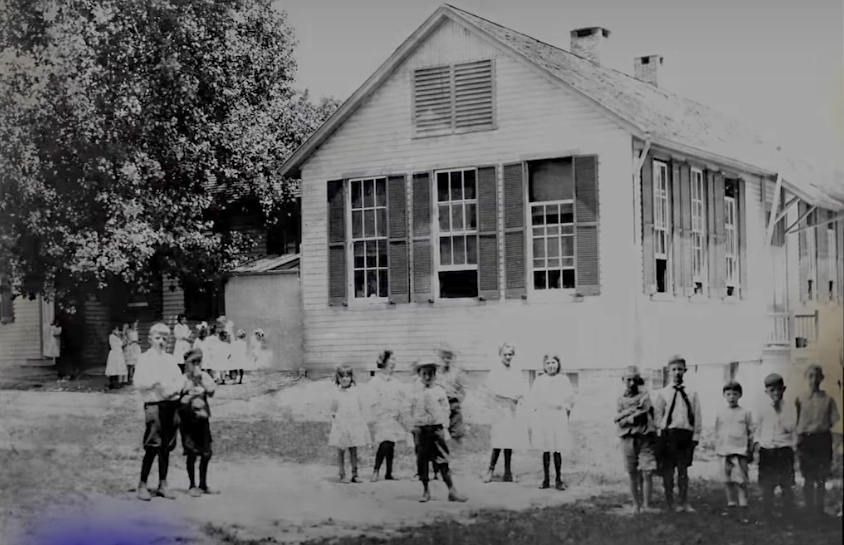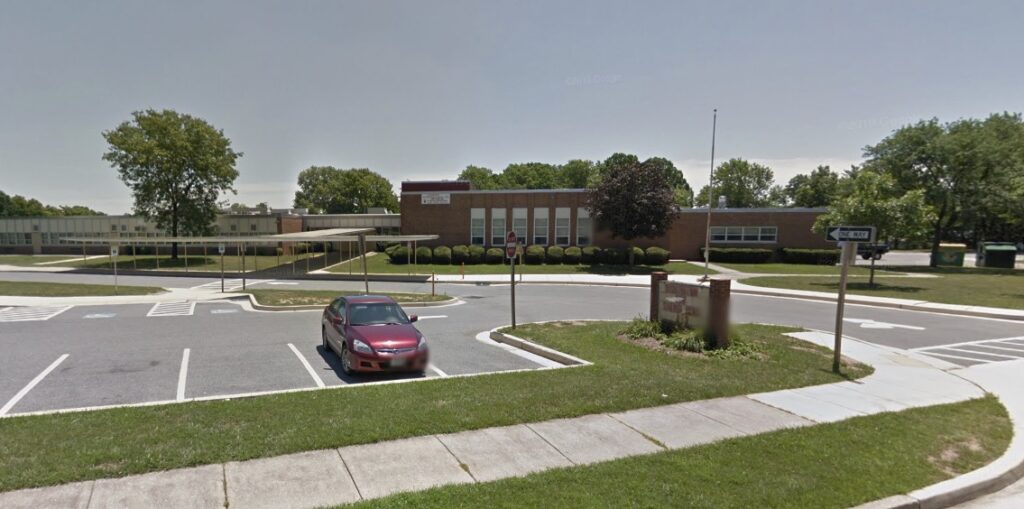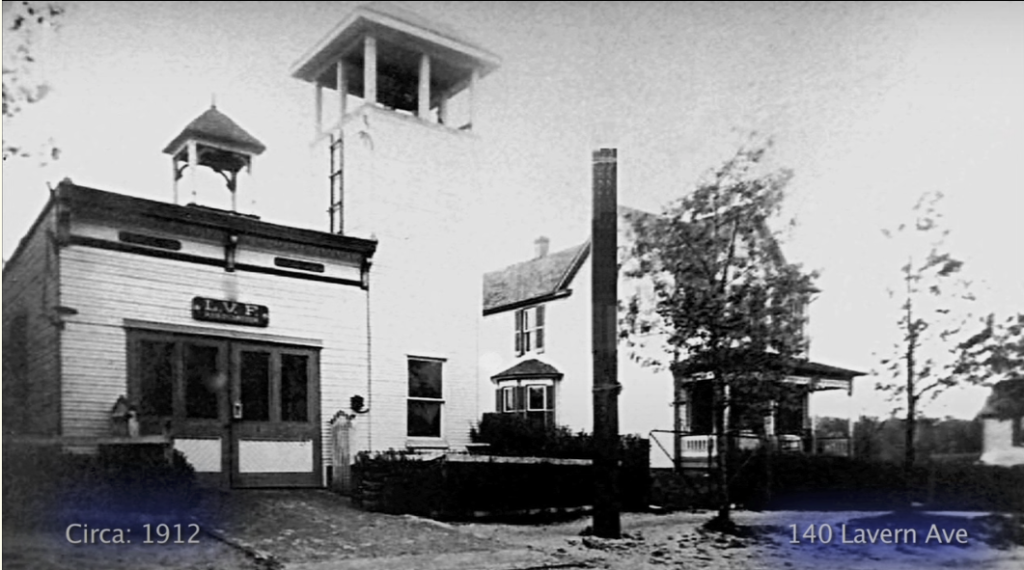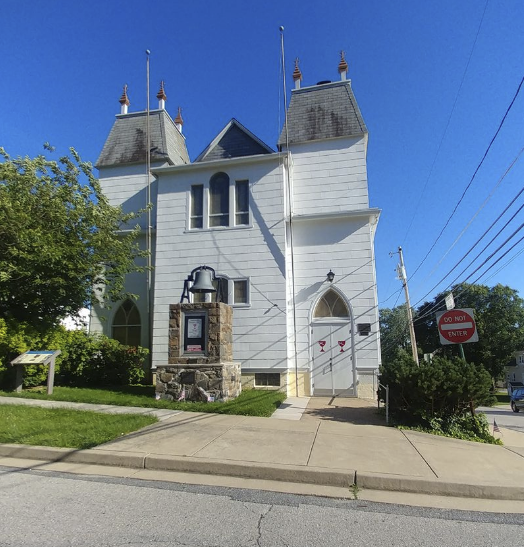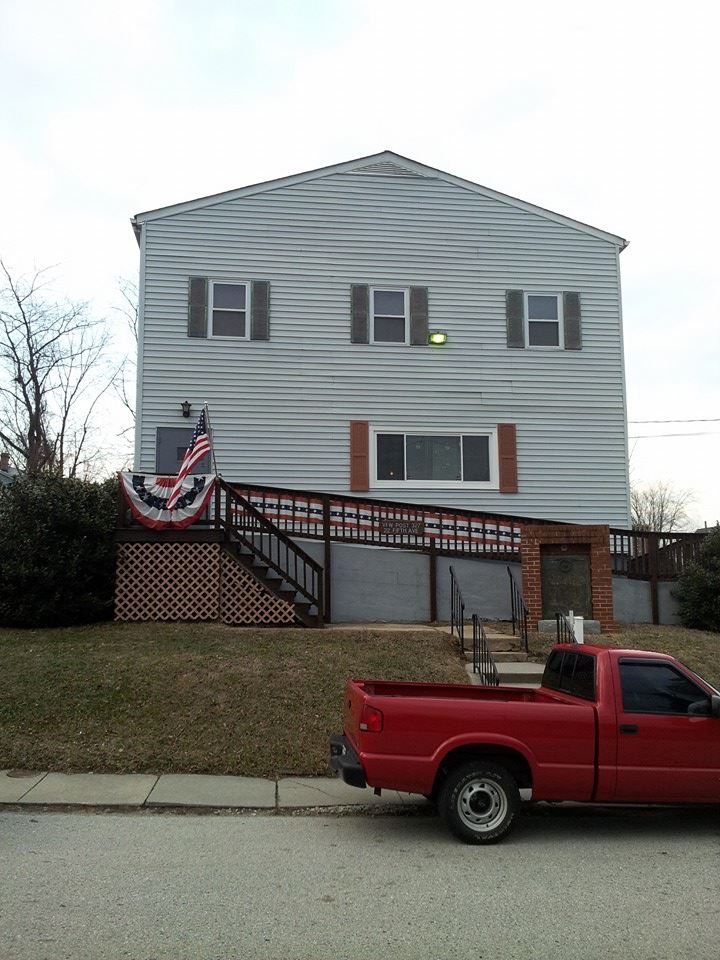Lansdowne, Md History
Acknowledgments
The following first three paragraphs were extracted from:
History of St. Clement’s Parish – Early History of Lansdowne, retrieved 15 January 2016
[https://docplayer.net/21803271-History-of-st-clement-s-parish.html]
From the fourth paragraph and thereafter, information was obtained from periodic background reading, but the bulk of it was borrowed directly from the YouTube video presentations of Mr. Jim Klima, Dan Cosgrove, Mary Bahr as well as documentation from the, now defunct, Lansdowne Historical Society. These and many others contributed to the creation of http://lansdownemdhistory.com/lansdownemdhistory/Organizations.html. On this site you will find most of the following information laid out in an easy-to-follow web page with multiple video and photo links.
The following is a summary of that information in a ventured, yet limited chronological fashion. Let’s begin.
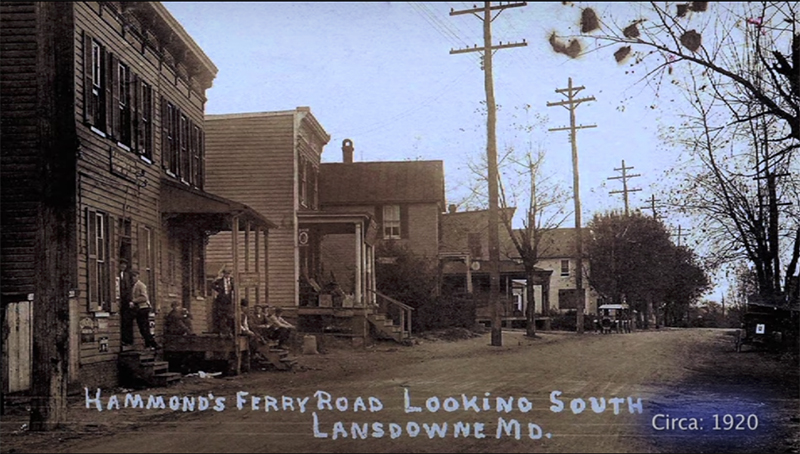 The earliest written records of Baltimore County show that during colonial times, the area we now know as Lansdowne was called “Hunting Ridge”. Early maps of the 1600s show that this area extended north between the Patapsco River and the Gwynns Falls. The area was so named because farmers from the present-day area of Baltimore City would travel to this area to hunt wild game. The earliest recorded land grant in the area was surveyed and recorded in 1667 for a gentleman farmer from Baltimore City. Thomas Roper, therefore, was the first land owner in the area and he called his 300-acre tract “Roper’s Increase”. The surveyed land was a narrow strip of land that ran from the Halethorpe area into the center of Lansdowne. 9 (Author’s Note: Baltimore, Maryland was incorporated as a city in 1796. It was previously established as a town in 1729. In 1851, Baltimore became an independent city, separate from Baltimore County.) 12
The earliest written records of Baltimore County show that during colonial times, the area we now know as Lansdowne was called “Hunting Ridge”. Early maps of the 1600s show that this area extended north between the Patapsco River and the Gwynns Falls. The area was so named because farmers from the present-day area of Baltimore City would travel to this area to hunt wild game. The earliest recorded land grant in the area was surveyed and recorded in 1667 for a gentleman farmer from Baltimore City. Thomas Roper, therefore, was the first land owner in the area and he called his 300-acre tract “Roper’s Increase”. The surveyed land was a narrow strip of land that ran from the Halethorpe area into the center of Lansdowne. 9 (Author’s Note: Baltimore, Maryland was incorporated as a city in 1796. It was previously established as a town in 1729. In 1851, Baltimore became an independent city, separate from Baltimore County.) 12
During the 1700’s, the area was settled by farmers. One of the largest farms was run by the Kessler family that stretched from Riverview to the Patapsco River. Three other farms occupied the majority of the remaining land in the Lansdowne area and were owned by the Linthicum, Coursey and Carney families. Most of the land from what is now Third Avenue to the Patapsco River was a swampy willow garden and the local farmers weaved some of the switches into baskets for their own use and the rest to be sold.
At that time, the farmers in this area were very poor when compared with the farmers in Baltimore. The farmers in the rural area lived in very crude mud and log cabins, which usually were never bigger than one room. The Lansdowne farmers would take their goods to the city of Baltimore harbor by way of the oyster shell-covered Hammonds Ferry Road and the Columbia Pike, which is now called Washington Blvd. Both the Hammonds Ferry Road and Hollins Ferry Road were so named after the men who ran the ferries that would cross the Patapsco River. A toll would be charged by these men for the crossing on a small barge-like craft that was tethered by rope to the riverbank to keep it from going downstream.9
The three large farms that are called out in the video presentations are the Coursey, Carney and Linthicum farms. This was the area primarily to the east of the B&O rails as they passed through the area. This is the bulk of what we know as Lansdowne today. According to Baltimore County Atlases dated 1857, 1863 and 1878, other farmers and land owners primarily to the west of the B&O rails as they passed through Lansdowne included the names: Eichelman, Tiemann, Odensoss, Rittenhouse, Deering-spellings vary, Randall, Wade, Link, Biden, Shriver, Nine and Caton.
On July 4, 1828, at the age of 91, Charles Carroll of Carrollton broke ground and dedicated a ceremonial cornerstone for the first stone of the Baltimore and Ohio Railroad At that time, he was the last living signer of the Declaration of Independence. 7
This was the beginning of the construction and grading on the first twelve miles of railway from Mt. Clare to Ellicotts’ Mills (Ellicott City).
Local resident and filmmaker Dan Cosgrove did much of the research for the history of Lansdowne and also presented that history along with Jim Klima, another Lansdowne resident and historian and an excellent orator, to the Baltimore County Historical Society. As it happens, Dan is the great-great-great-grandson of Larry Cosgrove who did the actual digging for that cornerstone. At that time, the B&0 used horse-drawn open carriages and charged 75c for the full one-way trip. This train service made Lansdowne suitable for suburban home building by transportation of building materials.
In the 1830s, iron ore was discovered in the area. It is thought that this area was mainly the land between Mine Bank Lane and Smith Avenue.10
On March 5th, 1838, a Pennsylvania mining engineer by the name of Rosby Carr bought the land from Mine Bank Lane to Smith Avenue. The area was then known as Carrsville in his honor.1 It is uncertain who Carr purchased the land from. Most of that area was owned by the Coursey family at that time. I do have an 1857 Map of Baltimore City and County and an 1863 Military-Civil War map of Baltimore County that shows “R. Carr” as land owner for that area. I have noted that if Rosby Carr sold the land to Mathias Linthicum in 1857, his name should not be on the 1863 Map. This is a military map; and was, perhaps drafted using the 1857 land ownership information because it was recent.
(Author’s Notes: In the video, “The Lost Village” at 6:08, Jim Klima indicates “On March 5, 1838, a Pennsylvania mining engineer by the name of Rosby Carr bought the land from Mine Bank Lane to Smith Avenue. The area was known, of course, as Carrsville”
In the Video “Living in the Past” at 3:11, Dan Cosgrove indicates the area was not named Lansdowne; however by 1835, the area we know as Lansdowne meaning 1st through 5th Avenue was named Brunswick (1835-1838)….on May 5, 1838, the name changed to Carrsville (1838-1857). During this period, commercial mining for iron ore took place which continued until 1857 when the area was sold to Mathias Linthicum (1857-1889) who… used 1st through 5th as farmland. On March 23, 1889, Mathias Linthicum sold his farm and the area became Lansdowne.
None of this is contradictory. It just begets several questions: Who owned the land between Mine Bank Lane and 1st Avenue before 1889 or was it a land grant to the Whitaker Iron Company or Rosby Carr? In the video “The Lost Village” Jim states that Carr purchased the land from Mine Bank Lane to Smith Avenue. In the video “Living in the Past”, Dan states that in 1838, the area from 1st through 5th Avenue (known as Brunswick 1835-1838) became known as Carrsville.
Did Rosby Carr purchase all the land in 1838 from Smith Avenue south to 5th Avenue?
Where did the name Brunswick come from? I have not found the name on any Baltimore County District 1 or 13 maps that are available online from the Library of Congress or the Baltimore County Public Library. Through the 1820-1830 censuses, I could only find that there was a Brunswick in Frederick, MD during this period. There was/is a Brunswick in England, but its history does not correlate with the 1830s in the U.S. There is also a New Brunswick in Massachusetts which, no doubt, does stem its name from England.) There are no surnames of Brunswick in the census records for that time period. The name does not appear on any maps or atlases indicating land ownership in the 1800’s.)
The ore, though of poor quality, was still valuable for refinement and found near the soil surface and could be easily removed. An English firm, The Whitaker Iron Company, began to dig for this ore. These digs resulted in the formation of lakes still present in this area.
The mining created great depressions in the land; and as they were exhausted and abandoned, they filled with water either from rain or underground springs. They became ponds and lakes that were used for fishing, ice skating and swimming. One large lake was called “Red Lake” due to the red clay that covered it. There was also Pine Tree Lake, Third Lake and Snake Bottom Lake. There were more, but that is all I can recall now.11
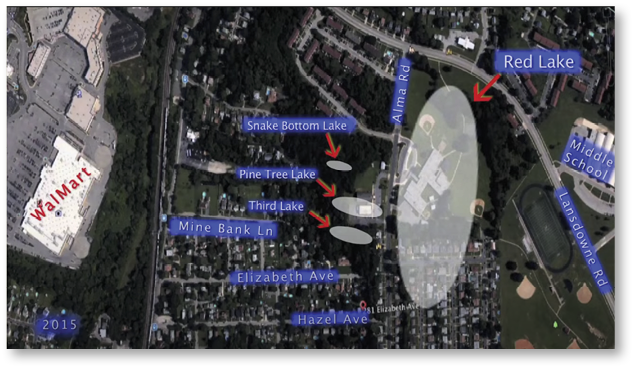 When it rained, Red Lake would overflow and form a stream that traveled parallel with Elizabeth Avenue and eventually emptied into the Patapsco River.2
When it rained, Red Lake would overflow and form a stream that traveled parallel with Elizabeth Avenue and eventually emptied into the Patapsco River.2
The iron ore was then transported by mule cart down the dirt roads to the iron furnaces at Elkridge Landing which, at that time, was a busy port. Mining continued for about another 20 years.3. One of these roads became Mine Bank Lane, so named because it was the main road used by the iron ore company that didn’t cross farm land.
The mine was not very productive; and Mr. Carr, the second owner, sold his holdings to a group of men. The majority investor in this group was Mr. Lansdowne. It was under his direction that the Lansdowne Company purchased farmland for investment with hopes that the newly planned railroad would make the land more profitable.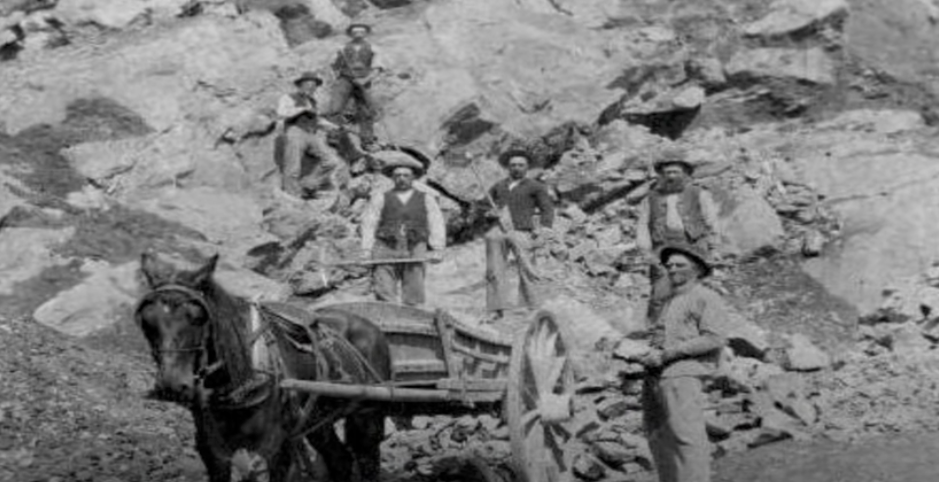
(Author’s note: In my research, I have never noted a “Mr. Lansdowne”. There are two accounts. One is this one naming a “Mr. Lansdowne” with no given name. The other is that of Samuel Crothers who formed the Lansdowne Real Estate Company and named it as such in honor of Dublin-born, Sir William Petty whose titles included Earl of Shelbourne and the Marquis of Lansdowne. As Prime Minister of England, Petty negotiated the peace with the new United States in 1783. I believe most will believe the latter because it is more intriguing and majestic; however, there may be some truth to both.)
The Lansdowne Railroad Station was much of a community center. It was built in 1892 and had a waiting area for the ladies and a smoking room for the men. The railroad kept it decorated with flower beds that bloomed spring through fall. Residents met there in the morning and evening to travel back and forth to Baltimore to work at the B&O for a 5-cent fare.8 The station was destroyed by fire in the 1950s.
On March 23rd, 1889, the Linthicum family sold the land between First and Fifth Avenue, then called Brunswick to Mr. Samuel Crothers who took out a mortgage of $40,000 for 428 lots. He partnered with an Irishman named McGrath. McGrath’s job was to promote the development of the village. He spent six years on the project. He named the business the Lansdowne Real Estate Company. As mentioned, this name was in honor of Dublin-born, Sir William Petty whose titles included Earl of Shelbourne and the Marquis of Lansdowne. Mr McGrath promoted the development of Lansdowne by standing on a corner in Baltimore City-we think somewhere near Camden station-and gave out free tickets for rides on the B&O train to Lansdowne so people could see the village. He said the land was, and I quote, “near the railroad transport, scenic, free of malaria and had clear pure air”.6
The newly formed Lansdowne Building Lot Company owned by Crothers sold lots of 25’ x 100’ for $60.00 with terms of $10.00 down and $5.00 per month. The Company also arranged for the B&0 to transport the building materials for the homes at half rate. A large number of the new homeowners were employed by the B&0 and commuted to the workshops in the city from one of two stops, Monumental Avenue or Carney Station to and from a small two-room station on what is today the Lansdowne Inn parking lot.
The Lansdowne Building Lot Company also sold a large section of its land to Charles Wesley Hull. He purchased the land from Mine Bank Lane to Clyde Avenue and named it Joshua after his son. Most of the street names in the area were believed to have originated from the names of the early residents.
Mr. Charles W. Hull began to develop this area of Lansdowne known as Joshua or Hilltop. Joshua was/is the area between First Avenue and Mine Bank Lane. Mr. Hull was likely a public-spirited and visionary for the developing community because, in the next few years, he donated land for three Protestant churches and the Lansdowne Fireman’s Hall. 4
More detail about the area was written and published by Lansdowne resident, Doris O. Marks on August 20, 1938. The following is transcribed from the YouTube presentation. Most is verbatim; but because we speak differently than we write, some of the following has been paraphrased for easier reading and integration with the rest of the history of Lansdowne.
Otto Wilhelm Haberkorn (1852-1943) purchased lots from Crothers at Hammonds Ferry Road and Second Avenue. Here, he opened a saloon and amusement park. Large numbers came from Baltimore City on Sundays for a day of pleasure in the country. Word spread and by 1892, the Baltimore and Ohio Railroad built a station there. Shortly after, large crowds began traveling from the city to Haberkorn’s Park and the B&O was forced to run special trains to Lansdowne.
A Little about the Churches
In 1891, the first church was opened. St. Clement’s Parish, a mission church of St. Jerome’s opened and Father Holden was the first priest to officiate in the parish. Follow this link for more information about the history of St. Clement’s.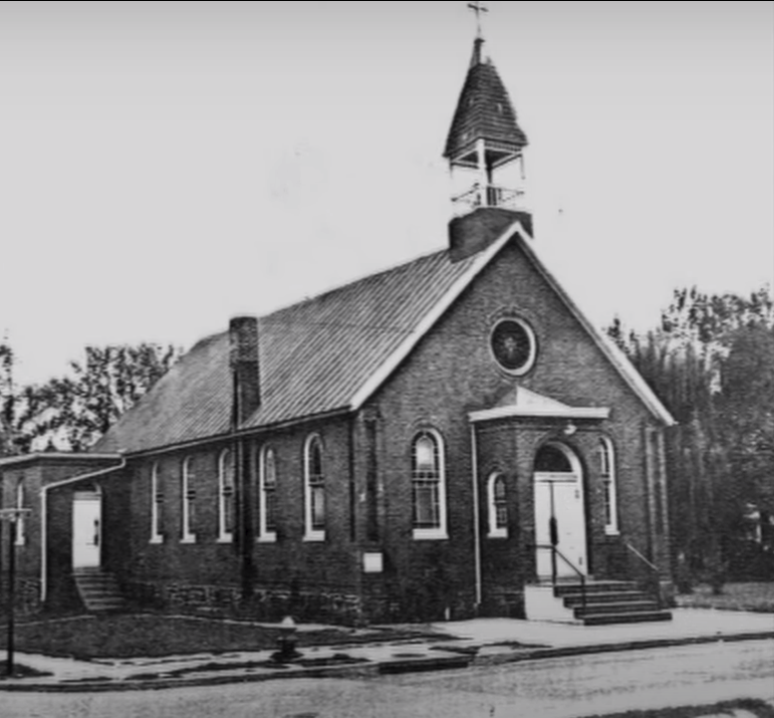
In 1891, a Lutheran congregation was organized and the first service was held in a store room at 137 Clyde Avenue. The following year, a small church was erected at 141 Lavern Avenue. The Reverend Conrad B. Gohdes was called to serve as the first pastor.
A few years later, the Methodist Church began holding services at Hammonds Ferry Road and Elizabeth Avenue. This building served in many capacities over time: The Lansdowne Hotel, the A.Z. Wilson store, Waranch’s store and Goldberg’s store. About 1894, they built their house of worship on the corner of Baltimore Avenue and Laverne Avenue. This church was famed for its annual Sunday school picnics and people came from far and wide to attend. The railroad ran special trains on that day to bring many to enjoy the festivities.
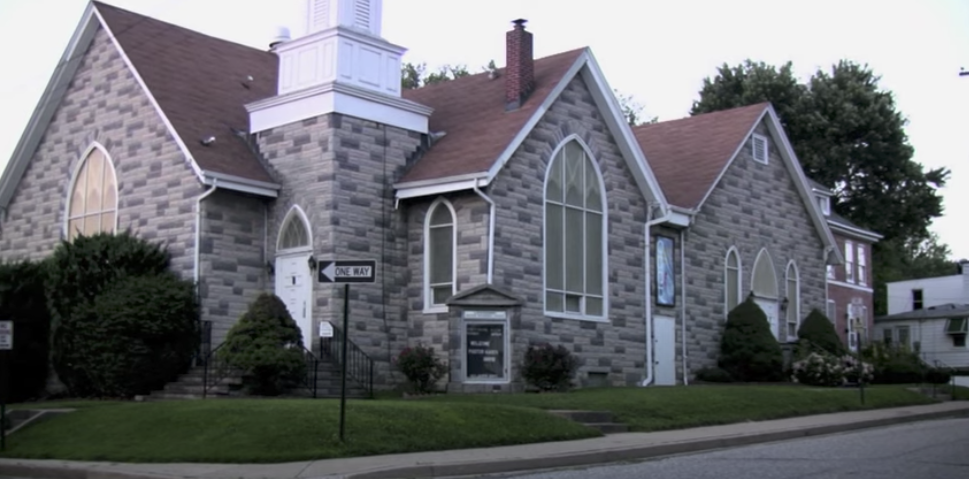 In April 1929, ground was broken for a new Lutheran Church at the same Laverne Avenue location. As mentioned, services were held in the original Lutheran church established in 1891 at 137 Clyde Avenue. The new Our Savior Lutheran Church was erected and opened on December 1st of that year at 141 Laverne Avenue. Sadly, on December 24, 2017, the last service was held marking the end
In April 1929, ground was broken for a new Lutheran Church at the same Laverne Avenue location. As mentioned, services were held in the original Lutheran church established in 1891 at 137 Clyde Avenue. The new Our Savior Lutheran Church was erected and opened on December 1st of that year at 141 Laverne Avenue. Sadly, on December 24, 2017, the last service was held marking the end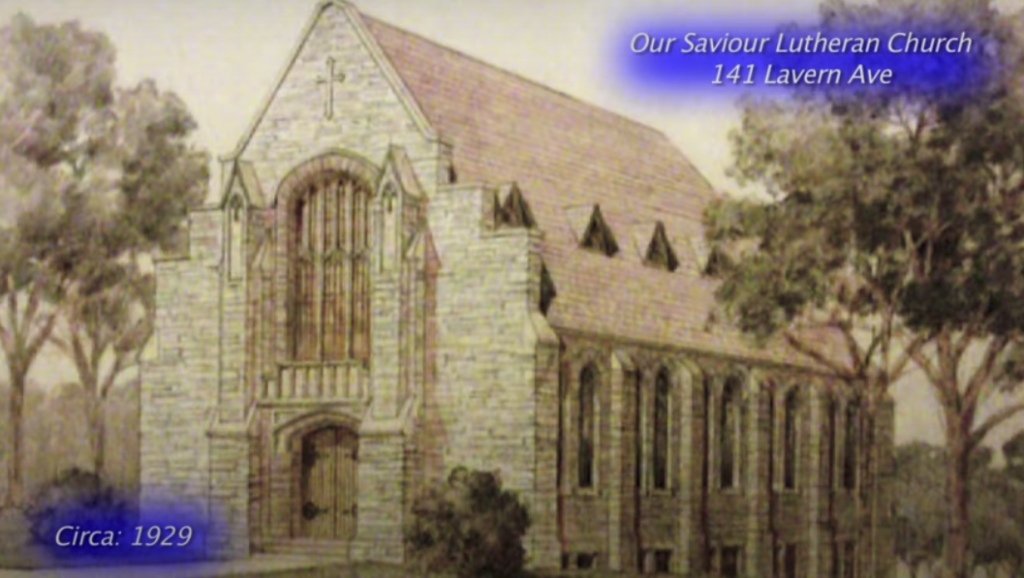 of 126 years of existence for the congregation. A YouTube video of that service is available at: https://www.youtube.com/watch?v=sIUphtBrw2E
of 126 years of existence for the congregation. A YouTube video of that service is available at: https://www.youtube.com/watch?v=sIUphtBrw2E
A Little about the Schools
As the area began to populate, the need arose for a school. Classes were temporarily held at 4 Fourth Avenue where the Knights of Columbus had made their home in recent years.
In 1892, a one-room wooden schoolhouse opened on Second Avenue, near Washington Avenue. Three years later, the school had expanded to three rooms and by 1916 had grown to five rooms, but was overcrowded.
In 1919, a group of determined women began the fight for a new school. The crowded conditions, even in the temporary structures, were woefully inadequate. They were known as the Patron’s Club. They insisted on a large and modern school. They canvased Lansdowne with petitions. They stormed the offices of the Board of Education until, at last, they paid them heed.
In 1920, the cornerstone for the new school located at Washington and Clyde Avenue was laid and all in the community rejoiced. This new school was brick and comprised of ten classrooms, an Industrial Arts room and a Domestic Science room. A short time later, St. Clement’s Parish purchased the old wooden school for parochial students. The old wooden school was used by these students until 1968. Today, it functions as the parking lot for St. Clement’s Church.
By 1957, both this new Baltimore County school and the old wooden school purchased by St. Clement’s were overcrowded. In that same year, Baltimore County opened Riverview Elementary School on Kessler Road and St. Clement’s opened a new elementary school on First Avenue in Lansdowne to alleviate the crowded conditions.
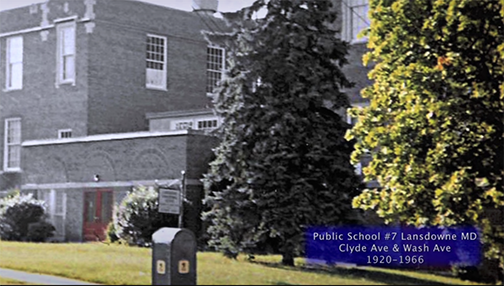 The brick school building opened in 1920 and was used for Baltimore County public school students until 1966. It was torn down in 1987 and replaced with a senior living facility named Coursey Station-named after the first railroad station in Lansdowne which took its name from the Coursey family that once owned the land.
The brick school building opened in 1920 and was used for Baltimore County public school students until 1966. It was torn down in 1987 and replaced with a senior living facility named Coursey Station-named after the first railroad station in Lansdowne which took its name from the Coursey family that once owned the land.
In 1965, a new Baltimore County Public Elementary School was opened on Alma Road followed in 1971 when Baltimore County opened its first middle school on Lansdowne Road. The 1965 elementary school was torn down and replaced at the same location shortly after 2018.
Prior to 1963-64, Lansdowne bused high school students to other areas to attend school. In 1964, Baltimore County opened Lansdowne Senior High School on Hollins Ferry Road. At some point, the school was renamed and is still known today as Lansdowne High School Academy for Advanced Professional Studies. With development and over time, this school too has become outdated and insufficient to meet the current needs of the community. As of this 2024 writing, a new Lansdowne High School is being erected on Lansdowne Road in the back of the existing high school. In surveying the progress, it doesn’t appear to be opening until 2025.
Returning to Earlier Community Development
Prior to 1902, the closest fire department for the community was in Mt. Winans. Due to distance, weather and other factors, more than nineteen Lansdowne homes were lost to fire. Residents felt that many of those homes could have been saved if they had their own fire department. In the beginning of 1902, a group of prominent citizens met at Mr. Haberkorn’s home at Hammonds Ferry Road and Second Avenue and the Lansdowne Volunteer Fire Association was organized. Mr. Hull donated a lot and a small engine house was built later that year. Several members donated time, money and services to make this new organization a success. Many Fire Company activities were enjoyed by all of Lansdowne. Money was raised by holding oyster and bull roast. A gala annual parade was held every Thanksgiving and annual picnics were held in May. Everyone in Lansdowne was invited to attend.
About the same time, a group of men organized the Lansdowne Improvement Association and began a long fight for improvements that were being enjoyed by other communities throughout the county.
Later in 1909, Charles W. Hull began developing land in the English Consul area after purchasing 766 acres on Old Annapolis Road for $30,000. However, Hull is best remembered as the founder of the Lansdowne Christian Church at 101 Clyde Avenue corner of Clyde and Baltimore Avenue. In 1977, this structure was listed on the National Registry of Historic Places, part of the American Civil War Trail and was dedicated to the Grand Army.
Grand Army Day was celebrated by the residents of Lansdowne on May 3oth each year. Veterans of the Civil War, both Union and Confederate, used to come to Lansdowne every year on a special train. They would form into ranks and march to the Christian Church-Hull Memorial 101 Clyde Avenue. They would have a service and then a picnic in the church or the grove outside the church5
The chaos of the First World War affected Lansdowne when 70 of their young men answered the call to their country in its time of need. Just as every other town and village suffered, so did Lansdowne. The citizens prayed and waited for the return of their loved ones. Three young men made the supreme sacrifice. The entire community welcomed back their heroes with a celebration in the Fireman’s Hall.
By January 20, 1920, veteran Walter-Howard-Shaw Post 327-veteran of foreign wars had been organized and received its name for three Lansdowne men who had given their lives for their country. These ex-servicemen along with their ladies’ auxiliary kept the memory alive of the World War and fostered a spirit of patriotism throughout the community. Today, it is over 100 years old and the oldest active VFW Post in the state of Maryland.
Lansdowne continued to prosper and grow. Hard-working men and women made their homes here. New houses were springing up everywhere. In 1925 when city water was installed, the citizens rejoiced; but moaned at the heavy tax burden.
In the Spring of 1928, gas service came to Lansdowne. This was great progress for the entire community.
The Depression struck with full force. Many life savings were lost overnight and unemployment descended without notice. Many citizens were forced to earn a bare livelihood by any means that could find. Many could not find employment and were forced to accept help wherever they might find it.
One good thing happened at this time. Baltimore Avenue was selected as a federal project. This employed over 60 Lansdowne men in making improvements to the street. Slowly Lansdowne recovered.
The Depression years were hard on the Volunteer Fire Department. In 1937, there seemed to be no solution but to dissolve the organization. Funding and community support were 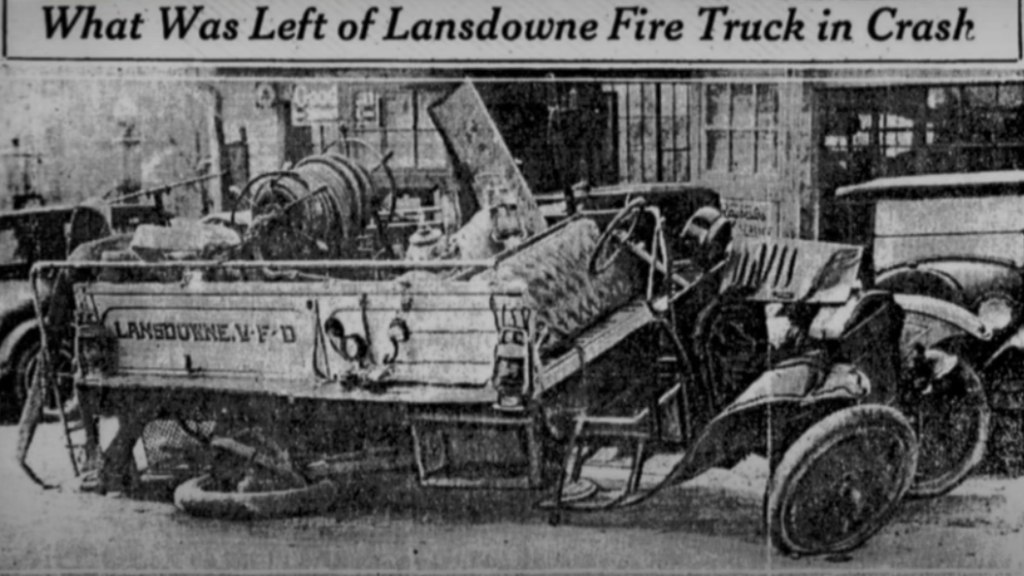 lacking in the welfare of this organization. Meetings were held and through consultation of Mr. B. H. Shipley, state president, a ladies auxiliary was formed. This group of determined women began to work; and before long, all of Lansdowne began to take interest again in the volunteer fire department.
lacking in the welfare of this organization. Meetings were held and through consultation of Mr. B. H. Shipley, state president, a ladies auxiliary was formed. This group of determined women began to work; and before long, all of Lansdowne began to take interest again in the volunteer fire department.
In his memoirs, Leonard Marion Bahr (1905-1990), a notable American portrait painter, muralist, illustrator, educator and Lansdowne resident spoke of returning from the war, referring to WWI, with great hopes and desires. He expressed how difficult it is to describe the Great Depression unless you lived through it. He recalled one man attempting to cut grass but passed out from hunger before he could begin.
One of the lowest points he recalls is traveling all the way to East Baltimore to paint the prices on a meat store window in exchange for a piece of ham.
Being in a railroad town, the train would pass through Lansdowne loaded with men piled on top of the cars who were all out of work. 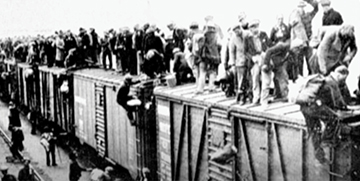 At the Lansdowne Station, about twenty men would hop off the train looking for work; and about the same number would climb on also seeking work elsewhere.
At the Lansdowne Station, about twenty men would hop off the train looking for work; and about the same number would climb on also seeking work elsewhere.
Leonard’s brother, Maurice Bahr also spoke of Lansdowne in his early years and referred to a photo from an article he wrote called “When Geese, Cows Roamed Lansdowne Streets” published in the Baltimore Sun on February 20, 1966.
The streets were red or blue clay and the houses set well back from the streets. As a youth, I hauled water from a spring far behind the house. I used a wagon in the summer and a sled in the winter. Later, my father installed a thousand-gallon cistern to catch rainwater for general household use.
Beyond a meadow in the back of the house was a German farmer who ran a small dairy farm. We grew most of our own vegetables. Our meat came from a store down the street run by a family named Fineburg. General groceries were purchased from the Z. A. Wilson store on the corner of Elizabeth Avenue and Hammonds Ferry Road. Sometimes groceries were transported home in a basket; and other times when it was a large load, a Robert Walter who worked at the store would transport them to our home in a two-wheeled mule cart.
Across the street was a wooded area where we would find a variety of fruits and berries: pears, apples, wax and black heart cherries, hickory nuts and persimmons. This wooded area may have been a farm at one time, but it had been reclaimed by the woods. There was also a collection of wildflowers: violets, lady slippers, trailing arbutus, laurel and a carpet of crow’s foot.
Lansdowne was a peaceful little town. In the winter, the whole town turned out for skating on the ponds; and in the summer, there were church picnics both in the church and in the woods. The area was also full of willow gardens. Residents cultivated them for switches for basket making.11
As a child in the 1970s, I recall some of the remaining willows. To my knowledge, they are all gone now. Those weeping willows are beautiful and have graceful sweeping branches. They have a relatively short life span and thrive near water sources such as rivers, streams or swampy areas. Our proximity to the Patapsco River created a nurturing environment for them. They have shallow but invasive roots. Despite their beauty and because this area is now more thickly settled and we have underground infrastructures in place such as gas, sewer and water lines, they are not welcome any longer. The rural area that our ancestors once knew here is no more. Still, it’s nice to remember when…
1 The Lost Village, Retrieved 17 May 2020 [https://www.youtube.com/watch?v=wG8Xt9qkpaY&list=PLwYeYjT46_5-y9Tzq6ZNLMxZuS0GCxp8T&index=3]
2 The Historical Society of Baltimore County Presentation “The History of Lansdowne”
, Retieved 22 June 2021 [https://www.youtube.com/watch?v=_dHnUAu8wUk&list=PLORgDXXoiY9S5C4e8ZJ_uW3ZyHaUzLAHM]
3 The Lost Village, Retrieved 17 Janueary 2019 [https://www.youtube.com/watch?v=wG8Xt9qkpaY&list=PLwYeYjT46_5-y9Tzq6ZNLMxZuS0GCxp8T&index=3]
4 Doris O. Marks, 20 August 1938 Lansdowne History, Retrieved 8 June 2018
[https://www.youtube.com/watch?v=sb3d3PJVtXU&list=PLwYeYjT46_5-y9Tzq6ZNLMxZuS0GCxp8T&index=6]
5 The Lost Village Retrieved 26 May 2020 [https://www.youtube.com/watch?v=wG8Xt9qkpaY&list=PLwYeYjT46_5-y9Tzq6ZNLMxZuS0GCxp8T&index=3]
6 The Lost Village 17 May 2020 [https://www.youtube.com/watch?v=wG8Xt9qkpaY&list=PLwYeYjT46_5-y9Tzq6ZNLMxZuS0GCxp8T&index=3]
7 Lansdowne MD Living in the Past, Retrieved 2 March 2019 [https://www.youtube.com/watch?v=MFGgARDygNg&list=PLORgDXXoiY9S5C4e8ZJ_uW3ZyHaUzLAHM&index=3]
8 The Historical Society of Baltimore County Presentation “The History of Lansdowne”
Retrieved 22 June 2021 [https://www.youtube.com/watch?v=_dHnUAu8wUk&list=PLORgDXXoiY9S5C4e8ZJ_uW3ZyHaUzLAHM]
9 History of St. Clement’s Parish – Early History of Lansdowne, Retrieved 7 November 2016 [https://docplayer.net/21803271-History-of-st-clement-s-parish.html]
10 History of St. Clement’s Parish – Early History of Lansdowne, Retrieved 15 January 2016 [https://docplayer.net/21803271-History-of-st-clement-s-parish.html]
11 Bahr, Maurice J., When Geese, Cows Roamed Lansdowne Streets, The Baltimore Sun, February 20, 1966, p. 204.
12 Maryland State Archives Baltimore City, Maryland History 1700-1799.
